|
In the films of pre-1960s British cinema, there was nothing more resolute and dignified in the face of adversity than the upper middle-class. This was largely due to the fact that an actor with a working-class accent was unlikely to get cast in the lead role of a movie back then, unless they'd already made their name for themselves in music hall or radio, of course. And these actors almost always had such cultured voices, a result, no doubt, of all those elocution lessons that were once (and for all I know, may still be) an essential component of the training for any aspiring actor. Because I've never met anyone who speaks that way in real life doesn't mean that they didn't, of course, but even after watching any number of older British films in which everyone from fighter pilots to teachers to supposedly working-class mothers speak with that accent, I still always have a little trouble adjusting to a world that is supposed to reflect my own but in which nobody speaks as I or anyone I know does. But if the performances are solid and the storytelling brisk – as they so often were in British films of this period – you quickly adapt and get pulled into the film.

Take the first ten minutes of A Town Like Alice, director Jack Lee's well-respected and commercially successful 1956 adaptation of Nevil Shute's 1950 bestseller. When she unexpectedly inherits a sizeable sum of money, the frightfully well-spoken Jean Paget (a radiant Virginia McKenna) decides to return to a village in Malaya and build a well to provide fresh water for the local people. While there, she looks back to 1942, when she was stationed in an office in Kuala Lumpur. When the news comes in that the Japanese invasion force is approaching, she and her co-workers are ordered to immediately evacuate. Just as she is leaving, the telephone rings and against the advice of departing colleague, Jean pauses to answer it. The call is from the boss's wife, Eileen Holland, who has also been ordered to evacuate but cannot possibly manage her three children alone now that all her servants have gone. I couldn't help wondering how many working-class mothers who'd ducked and dived their way through the Blitz laughed out loud at this proclamation when they saw the film on its initial release. Instead of making her way to safety, Jean scurries round to help the flustered Eileen pack, but when Mr. Holland rolls up in his hastily repaired car to the sound of distant explosions and makes it clear that they all need to depart immediately, any sense of artificiality created by the way these people speak was quickly dissolved. A short while later, as the car malfunctions and stutters to a halt and an approaching vehicle forces them all to hide in a ditch, I was seriously on edge.
A chance encounter with a military driver and a truckload of evacuees sees them transported to a scantly staffed British Army post in Penang, where they quickly discover that all avenues of potential escape have been cut off. When the Japanese arrive (in a really tense sequence), the Army personnel are all killed in a brief fire fight. The men are loaded into a truck for transportation, while the women are told they will have to return to Kuala Lumpur, from where they will be moved to a prisoner-of-war camp for women and children in Singapore. But, they are brusquely informed, there are no trucks available to transport women, and they will have to walk the fifty miles to Kuala Lumpur. Even here, by when I was fully sympathising with the women's plight, I had my own small prejudicial twinges of empathy doubt. When one of the women indignantly confronts the Japanese army captain about the very idea that they could walk that distance in this heat, he informs them that Japanese women could do it. "We're not Japanese women," she immediately snaps back, to which the Captain replies, "No... you are the arrogant English," and I found myself secretly siding with him.
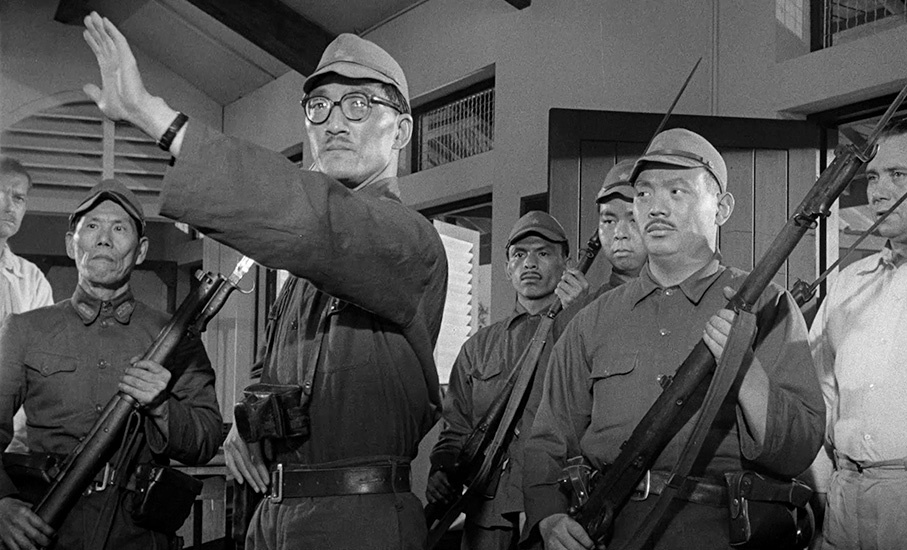
But once the walk gets under way, one for which the women are inappropriately attired and weighed down by their insistence on carrying their suitcases and the need to care for children and a baby, the punishing nature of this forced march soon hits home. Heat, tiredness, a lack of food and water and inherent medical conditions begin to take their toll, particularly on the weak and elderly in the group. Then halfway to Kuala Lumpur, they are informed that the railroad has been destroyed and that they are now being redirected to Port Swettenham, another fifty miles in a different direction. And with this, a seemingly endless cycle begins in which the group is turned away from every camp that it approaches and is forced to continue walking, an endurance test that has its share of fatal casualties, not all of them adults. These become trapped in a kind of nightmarish limbo, stripped of hope and forced to continuously wander with no final destination or visible end to their plight.
As the first to realistically assess the situation and adapt to it, Jean emerges as the group's unofficial leader and the figure around which the story continues to revolve. It thus makes sense that when they stumble across a pair of Australian servicemen who have been pressganged into driving trucks for the Japanese, it is she who strikes up a friendship with the cocksure Joe Harman (Peter Finch), one that over the course of a subsequent encounters evolves into something stronger and prompts both to take risks that put their collective safety in peril.
Being made just 11 years after the end of WW2 and based on a book written six years earlier, I'd steeled myself up for the invading Japanese to be painted in broad and unremittingly hostile strokes. But given the very real brutality unleashed by Japanese soldiers during WW2 and how fresh these memories still were for many, there is a surprising degree of restraint and balance to their presentation here. At no point are the women physically abused by the soldiers, orders are almost always politely delivered (the majority of commands conclude with the word, "please"), and only those who take a brief stand out of pride, anger or sheer desperation are in any way threatened. Unlike the male prisoners of war in such films as Bridge Over the River Kwai and Merry Christmas Mr. Lawrence, the women here are victims not of brutality but of disinterest and wanton neglect.
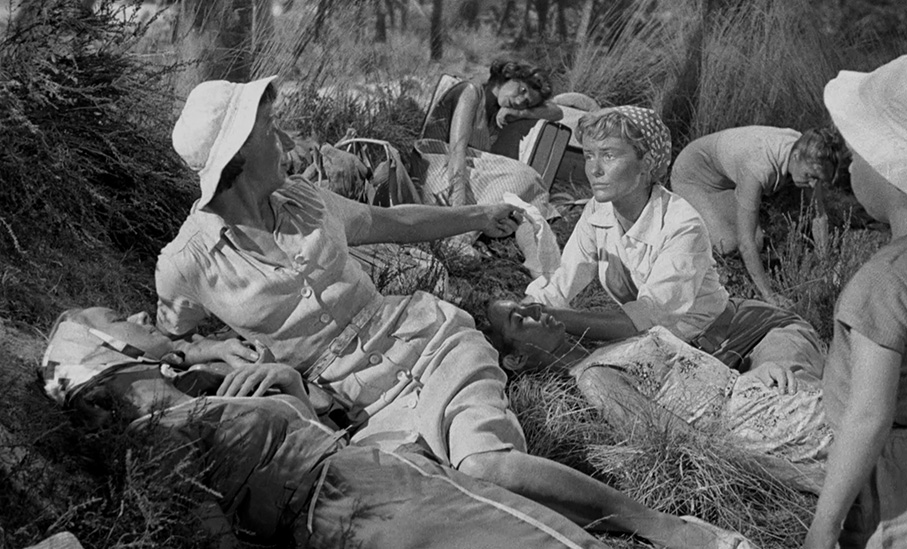
The more unpleasant aspects of Japanese military suppression and control are still briefly glimpsed in the beatings dished out to disobedient male POWs, while [big spoilers ahead – skip to the next paragraph if you don't know the story] the later crucifixion of Joe for attacking an officer after recklessly stealing five chickens from an unforgiving commander to give the women just one decent meal was drawn from fact. Joe Harmon was based on a "Ringer" Edwards, an Australian soldier captured by the Japanese who was crucified for 63 hours for killing cattle for food for himself and his comrades, but somehow managed to survive the ordeal. The commendable restraint shown elsewhere hits a peak here in director Lee's decision not to show the crucifixion, though he then comes close to overplaying his hand in the overt religious overtones of what immediately follows. We're also given a sympathetic Japanese soldier in the shape of the ageing sergeant assigned to guard the women, a man who rushes to the aid of a snake-bitten boy, shares his water ration with the exhausted children, and accepts the women's bribe of a chicken to turn a blind eye to their own meal preparations, for which he is later punished by being given the shameful job of being their sole guard as they continue their trek. It thus hurts when Jean vents her anger at what happened to Joe towards him just for being Japanese, a wrong she later attempts to right when she tenderly comforts the old man on his deathbed.
Lee's direction is consistently tight, waste-free, and is always focussed on the story and developing the characters. He's impeccably served by an excellent cast, with each of the women quickly established as rounded and sympathetic individuals, while Virginia McKenna and Peter Finch are at pretty much the top of their game as the seemingly star-crossed Jean Paget and Joe Harmon. Music is also economically rationed, effectively pushing the emotional buttons but not employed to artificially boost tension in scenes that play so much more effectively in silence. The intermittently visible switches (damn you, Blu-ray) between location shooting and back-projection close-ups is something you soon get used to, and turns out to be down to the fact that the film was actually shot in and around Pinewood Studios, with wide shots filmed in Malaya using identically dressed and similarly proportioned doubles. Those familiar with Nevil Shute's novel should not be surprised by the compression of scenes and character detail (a standard trait of film adaptations of literary works), but should probably be prepared for the fact that the film only covers the first two parts of the book. Whilst this may irk purists – the 1981 Australian mini-series adaptation starring Helen Morse and Bryan Brown is more complete on this score – I'd argue that the film as it stands concludes on just the right note, one that even had an old cynic like me (albeit one in a currently delicate emotional state) shedding a tear.
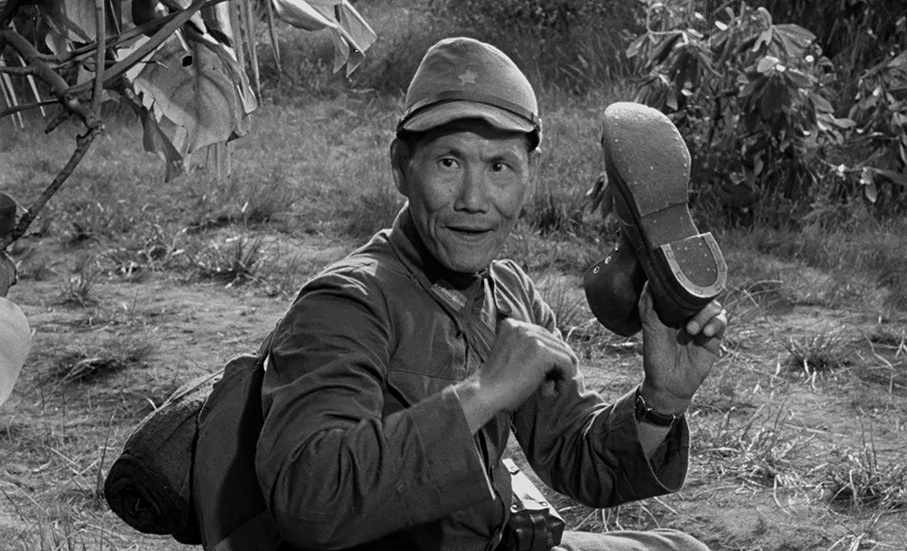
A Town Like Alice showcases the sort of unfussy story and character-centric filmmaking that that British cinema once had down to a tee, and while it does pare down Shute's original novel and lops off the last third, it still makes for a compelling and ultimately moving entertainment. Handsomely shot by Geoffrey Unsworth, it's leant an extra layer of poignancy by the knowledge that Jean Paget was based the real-life Carry Geysel-Vonck, one of a group of Dutch women captured by the Japanese during WW2 who were forced to march a total of 1,900 kilometres around Sumatra over the course of two-and-a-half years under similar circumstances. Only later did it emerge that this was actually a misunderstanding of Shute's part and that the women were actually moved from camp to camp by motorised transport. This, of course, would have made for a somewhat less interesting tale, which prompted The Nevil Shute Foundation to describe Shute's interpretation of events as "possibly the luckiest misunderstanding of his life."
A solid if not quite pristine 1.66:1 1080p transfer that although has been cleaned up still has a fair number of dust spots and other small blemishes, including a few brief scratches, all of which tend to be worse around what we can assume were the original reel changes. Picture sharpness and image detail are good, however, and the contrast balance is very well pitched, delivering solid blacks, no burn-outs on whites, and an attractive and detail-generous greyscale between. Even the darker night scenes are clearly rendered. Grain is very visible and there is some slight flickering on some of the wider shots, but nothing too distracting.
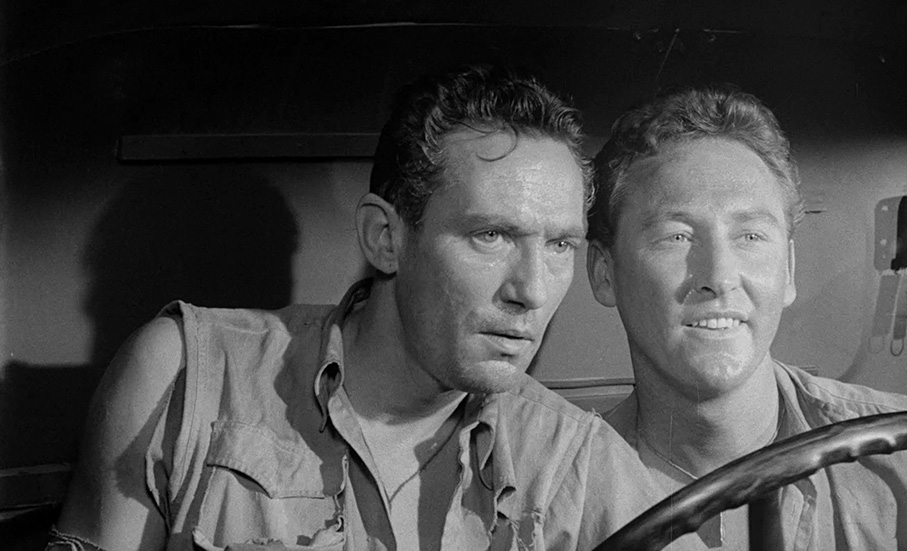
The Linear PCM 2.0 mono track is in fine shape, with very clear dialogue, solid reproduction of music and no distracting pops or background hiss. The dynamic range is inevitably narrower than soundtracks of more recent films, but is still better than a good many films of this period and some years after.
Optional English subtitles for the deaf and hearing impaired have also been included.
Archive interview with Virginia McKenna (5:31)
I'm betting the good people at Eureka were just a tad miffed to discover that Network had bagged this particular extra feature, given that it relates more to Virginia McKenna's role in the 1966 wildlife family drama Born Free, which Eureka are releasing on dual format in May. Originally transmitted on 23 January 1987 as a segment on The Six O'Clock Show, McKenna is interviewed here by Michael Aspel and talks primarily about her animal welfare work, though also has a story about taking her family on a Kenyan safari. There's a brief interruption near the end for a news bulletin that's not included here, and that's Chris Tarrant and Danny Baker seen briefly in wide shot on the couch at the end. Unsurprisingly, this is framed 4:3 and in standard definition.
Archive Interview with Peter Finch (13:23)
First transmitted on 31 March 1973 on The Russell Harty Show, this archive interview with Peter Finch is dated in the opening minute when Finch pulls out a packet of cigarettes, offers Harty one and both men light up and smoke their way through the studio chat. Finch proves a lively and engaging interviewee, and talks about acting and singing in Lost Horizon, his Buddhist upbringing, his press image as a hell-raiser, his upcoming marriage and more. There's also a very funny anecdote about an unnamed actor's encounter with what he thought was a mugger in New York. Again, this is framed 4:3 and standard definition, and rights issues have prevented the film clips screened during the course of the interview from being included.
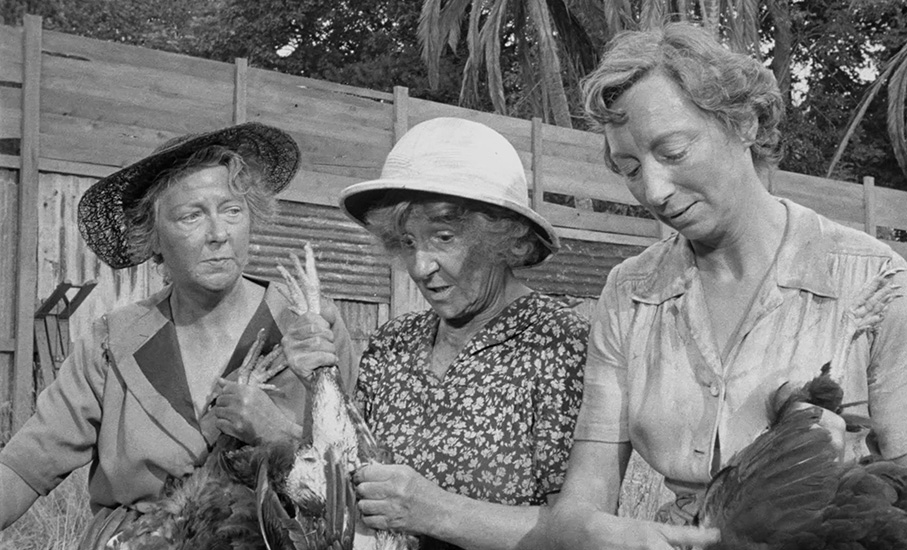
A Profile of A Town Like Alice (24:14)
Another standard definition, 4:3 framed extra, one originally produced in for the 1999 Carlton DVD release. It's a straightforwardly structured ‘making of' documentary, built around interviews with lead actress Virginia McKenna, director Jack Lee and supporting player Jean Anderson, and peppered with illustrative clips from the film. The genesis of the project and casting the lead actors is inevitably covered, and there's info on some of the supporting cast, including non-professional Takaki Kenji, who played the sergeant tasked with accompanying the women. Most interesting is the revelation (yep, this is where I learned this) that the film was shot largely at Pinewood and nearby Burnham Beeches and that doubles were used for wide shots filmed in Malaya, something I'd never have guessed from just watching the finished film.
Trailer (2:40)
A workmanlike trailer with a sideshow barker narration and a couple of spoilers.
Gallery
A solid collection of high quality images of posters, promotional stills and production photos, which can be manually advanced using the player remote control.
The sort of film that once gave British cinema its fine name, this very well made and thoroughly involving example of character-driven storytelling is commendable for its restraint, its performances, its refusal to paint the Japanese invaders in demonically cartoon colours, and the considerable emotional impact of its impeccably handled romantic elements. Although not as clean and pristine as Arrow-quality restorations, the HD transfer is still solid and at its best is very good, and the supplements are all well worth a look. Recommended.
|